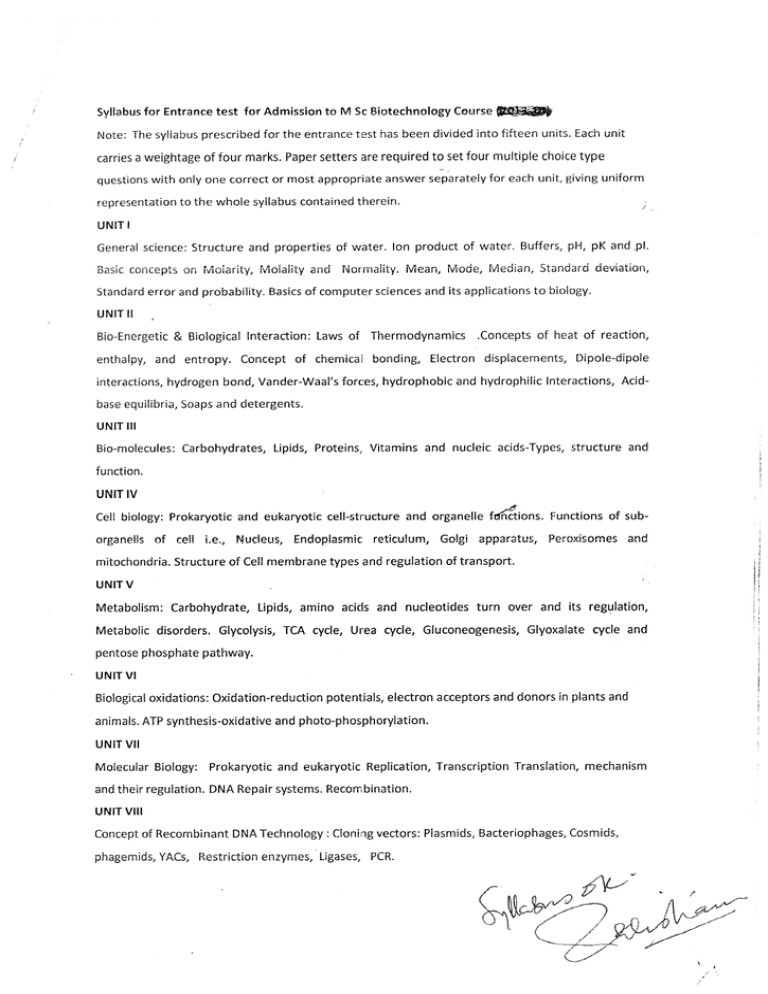carries a weightage of four marks. Paper setters are required to set
advertisement

Syllabus for Entrance test for Admission tn M Sc Bioteehnology Course regd&$ Note: The syllabus prescribed for the entrance test has been divided into fifteen units. Each unit carries a weightage of four marks. Paper setters are required to set four multiple choice type questions with only one correct or most appropriate answer separately for each unit, giving uniform representation to the whole syllabus contained therein. UNIT I General science: Structure and properties of water. lon product of water. Buffers, pH, pK and.pl. Basic concepts on tvlolarity, iv.iolality and Normality. Mean, Mode, Median, Stancjarci deviation, Standard error and probability. Basics of computer sciences and its applications to biology. UNIT II Bio-Energetic & Biological Interaction: enthalpy, and entropy. Concept of Laws of Thermodynamics .Concepts of heat of reaction, chemical bonding, Electron displacements, Dipole-dipole interactions, hydrogen bond, Vander-Waal's for<:es, hydrophobic and hydrophilic Interactions, Acidbase equilibria, Soaps and detergents. UNIT III Bio-molecules: Carbohydrates, Lipids, Proteins, Vitamins and nucleic acids-Types, structure and function. UNIT IV Cell biology: Prokaryotic and eukaryotic cell-structure and organelle fAffiiions. Functions of sub- organells of cell i.e., Nucleus, Endoplasmic reticu!um, Golgi apparatus, Percxisornes and mitochondria. Structure of Cell membrane types and regulation of transport. UNIT V Metabolism: Carbohydrate, Lipids, amino acicls and nucleotides turn over and its regulation, Metabolic disorders. Glycolysis, TCA cycle, Urea cycle, 6luconeogenesis, Glyoxalate cycle and pentose phosphate pathway. UNIT VI Biological oxidations: Oxidation-reduction potentials, electron acceptors and donors in plants and animals, ATP synthesis-oxidative and photo-phosphorylation. UNIT VII Molecular Biology: Prokaryotic and eukaryotic Replication, Transcription Translation, mechanism and their regulation. DNA Repair systems. Recon bination. UNIT VIII Concept of Recombinant DNA Technology : Cloning vectors: Plasmids, Bacteriophages, Cosrnids, phagenrids, YACs, Restriction enzymes, Ligases, PCR. A,4,V-/ S'$ry [-rNtT tx lmmunology: Innate and adaptive immunity, Antigen and super antigens. Structure and functions of immunoglobulin. T-cells and B-cells. UNIT X Bio-Techniques: Principles, types and ap'plications of Chromatography, Centrifugation, Electrophoresis, Spectrophotometry and Blotting tech niques. UNIT XI Genetics: Mendelian iaws of inheritance and their application, linkage and crossing over, gene mapping, theories of mutation and evolution, Genetic disorders. UNIT XII Animal & Plant physiology: Physiology and development of circulatory, nervous system. Endocrine and exocrine system: hormone diversity and action. Transport across plant cell, Transpiration, Photosystems, Flowering, plant hormones. Plant tissue culture and production of transgenic plants UNIT XIII Microbiology: Structure and organization of microbial ceiis, Microbiai growth, Transformation, Transduction, Conjugation. Antimicrobial agents. Drug resistance UNIT XIV Enzymology: History, general characteristics, nornenclature and classificatiop of enzymes, enzyme activity and factors affecting enzyme activity, Conlpetitive and uncompetitive inhibition, allosteric enzymes. UNIT XV Cancer biology: Cell cycle progression and regulation. Receptor mediated types of receptors, Secondary messengers, f,rotein modification cell Signaling. Different with specific emphasis on oncogenesis. Protein modification by phosphorylation and de-phosphorylation and the role in signal tra nsduction processes.